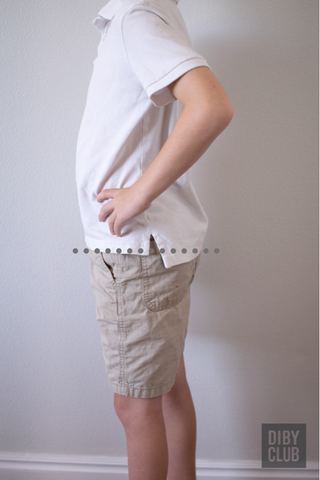Have you ever thought about making a custom garment for your child but stopped short of taking the measurements? We totally get it! It's hard to wrangle wiggly bodies, and when you finally do, where do you put your tape measure? Where do you write the measurements? How often do you measure?

Before we start...
We recommend taking your child's measurements each time you sew. They grow so fast!
Download our DIBY exclusive fillable children's size chart to keep track of your measurements! Download here!
To take all of these measurements you’ll want to use a fabric tape measure. Make sure the tape measure is not stretched out. You would be shocked at how often this happens, and with kids, a 1/2″ is a BIG difference. Nothing is worse than a tape measure that is stretched out and all those measurements go out the window.
Let’s wrangle the kids and get started, shall we?
Chest
This measurement is taken around the chest, right under the armpits right at the nipple line, with the arms down. Try your best to keep them from slouching.

Waist
This measurement is taken about 1/4” above the belly button. Lot’s of kids like to be silly and either puff out their bellies or suck in. Distract them into a relaxing that abdomen.

Full Hip
This measurement is the fullest part of the hips. Do this with them either wearing tight leggings or no pants at all.

Mid-Thigh
This measurement is just the midpoint between the crotch and the knee. If you don’t know just measure from the crotch to the knee, then divide it in half and you can find the midpoint.

Calf
This measurement is taken at the widest part of the lower leg.

Inseam
This measurement is the vertical distance from the midpoint of the crotch to the ball of the ankle. Some patterns measure this down to the floor. Consult your pattern’s instructions. If it’s not mentioned always err on the side of too long because you can always shorten them.

Arm Length
This is measured from tip of shoulder bone to the wrist with the arm bent at a 90-degree angle.

Total Height
This is measurement is the vertical distance from the top of the head to the floor.

Compare Your Measurements to the Sizing Chart
After you have all of your measurements, you are almost ready to begin sewing. Take your measurements and compare them to your sewing patterns in order to determine which size you will need to cut. If your measurements vary significantly between sizes, you’ll likely want to do what’s called “size grading“.
DIBY’s Children’s patterns differ from most PDF patterns because we offer patterns drafted in both a regular and slim fit. Check this tutorial out to see which pattern your child fits into.
I love sewing for my kids and they love it too. My kids grow inches overnight and I have to continually remeasure them. So knowing how to do it really helps and keeps my crazy level down.
-- Written by Nicole Cook. Archived by Holly Hetzner
